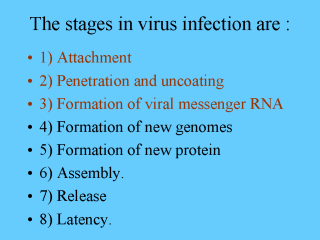| front |1 |2 |3 |4 |5 |6 |7 |8 |9 |10 |11 |12 |13 |14 |15 |16 |17 |18 |19 |review |
 |
1)
Attachment: the virus meets and then binds to a cell surface receptor, this explains
why viruses often only infect certain species or tissues eg liver compared to neurones 2) Penetration and uncoating: the virus is enveloped by an endosome and is degraded and its nucleic acid escapes into the cytoplasm, no infectious virus remains 3) Formation of
messenger RNA: Viruses have their own polymerase proteins which force the cell to make
a DNA viruses make mRNA in the cell nucleus. RNA virus make mRNA in the cytoplasm. Retroviridae are the exception. They transcribe double-stranded DNA which is then ligated by a viral integrase into the host cell chromosome as a chain of viral genes. |